As the country reopens, in-person college campus graduation events are part of the healing process:
- Students graduating from colleges are eager to walk across the stage instead of seeing faces through a monitor.
- Families and friends look forward to beaming with pride as they witness their loved ones earning degrees.
- College graduation officers are preparing graduation ceremonies, as is the tradition.
Safety, fortunately for all involved, is at the forefront of these preparations.
That is where CampusRight comes into play.
CampusRight is a mobile, automated, and integrated software system that offers the right mix of flexibility with dynamic forms, real-time access to student data, and a desktop-and mobile-friendly environment for the entire ticketing and event registration process.
Advantages of Digital Ticketing
When you are looking for a digital ticketing solution to your upcoming graduation ceremonies, you would be wise to consider a tool that offers a touchless form of ticketing.
As part of the preparations, CampusRight’s digital ticketing options can give everyone a safer alternative to the in-person distribution of paper tickets.
Digital ticketing options mean campuses can meet local regulations and virtually assure event safety. When paired with the Center for Disease Control (CDC), guidelines such as wearing masks and social distancing, visitor screening, and contact tracing, colleges can help restore confidence in attending events in-person. Providing digital tickets gives officers organizing graduation ceremonies a way to trace tickets back to the student who claimed them. By linking students to their campus IDs, graduation officers can maintain a complete audit trail and a roster of all expected attendees.
Additional benefits of digital ticketing include:
- Set a per grad ticket limit
- Changing ticket limits by ceremony
- Arranging interactive seating
- Allowing real-time access to student registration and ticket information
- Selling campus bookstore memorabilia
Interactive Seating
Part of staying in step with social distancing guidelines is ensuring guests sit in groups or "pods." With shifts in the rules around the number of attendees allowed at indoor and outdoor events, graduation officers may find it difficult to adjust quickly. An interactive seating map has an enormous impact on the graduation ceremony. Graduation officers can easily reserve sections of seats ahead of time. When college students who are graduating claim their graduation tickets, they can zero in on the perfect row or seats for their family and friends who plan to attend.
Check out the benefits of CampusRight
Whiteboards or printed maps and sticky notes are hardly the best alternatives for commencement officers. While coordinating graduations on campus, they may have many administrative duties or oversee other events simultaneously.
Some events typically don't require "assigned" seating, leaving it up to guests to find the ideal section to watch the ceremonies. This manual process often leads to seating disputes where one person is saving seats for a group. Ushers or school staff may intervene to resolve conflicts on what is supposed to be a happy occasion.
Even when graduation officers do not have time to manage guest seating, they must meet the Americans with Disabilities Act provisions. Reserving sections for guests with mobility issues, allowing service dogs, or assuring those with hearing and sight impairments will play a part in successful graduation ceremonies. Setting aside seating for special guests on the dais presents challenges, too, given how often guests can change from ceremony to ceremony.
That is where CampusRight can solve myriad issues for graduation officers.
Digital Graduation Tickets
Many ticketing platforms have desktop versions and mobile applications. CampusRight uses cloud-based software-as-a-service to produce digital graduation tickets. The advantage to using CampusRight is no logins or account creation is necessary for students. And graduation officers have accounts from which to monitor the ticketing from any mobile device.
When CampusRight is available, after students preregister for their ceremonies and select their guest tickets, colleges send confirmation emails with their tickets attached. Students can generate digital tickets and present them at graduation venues for scanning. Each type of ticket contains two barcodes to ensure perfect scanning.
Long-Term Thinking
Digital ticketing with CampusRight can help your campus during and after the current pandemic as a protocol. Think about the possibility of future emergencies that may require significant changes to how you plan the ticketing for graduation ceremonies.
To see these features in action, schedule a demonstration of CampusRight.



